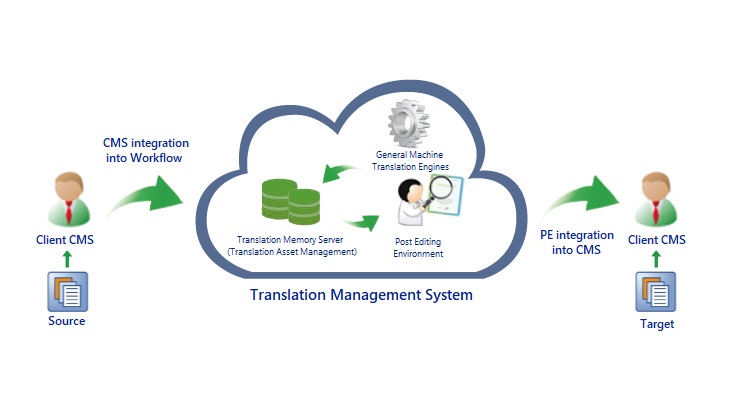
General (Baseline) Neural Machine Translation Solutions
Trusted Translations has developed a technology process that integrates baseline machine translation (MT) engines from AI leaders such as Google, Microsoft, Amazon, DeepL, and others, with translation memory (TM) servers and post-editing services to produce high-volume translations of the highest quality in the industry.

General (Baseline) Neural Machine Translation Solutions
Trusted Translations has developed a technology process that integrates baseline machine translation (MT) engines from AI leaders such as Google, Microsoft, Amazon, DeepL, and others, with translation memory (TM) servers and post-editing services to produce high-volume translations of the highest quality in the industry.
Machine Translation Related Content
Home » Services » Machine Translation » General MT Engines
Streamlined Process
Based on our client’s request and specifications, we will integrate a baseline MT solution with our quality control process to produce highly reliable and accurate translations. This proprietary process is shown to significantly improve turnaround times and lower costs while maintaining a very high level of translation quality.
General Domain Machine Translation Engines
A General Domain Machine Translation Engine (sometimes called “GMTE”) refers to a software program that can translate text to and from a certain language with little or no human intervention. While each of these baseline engines is built differently, most of them are designed to translate general content not involving specialized terminology―hence the name, General Domain Machine Translation solutions. The most popular ones are Google Translate, Systran, Microsoft Translator, Microsoft Hub, and Amazon.
For overall comprehension of relatively basic content, baseline engines can do a decent job. However, as of this date, customized engines still have a competitive edge. That is to say, the translations produced by GMTEs alone are not reliable enough for professional use, because errors are inevitable even for simple documents.
With that said, GMTE can be a useful part of a translation process, depending on the client’s objectives and the nature of the project. At Trusted Translations, we have learned how to leverage GMTEs and integrate them based on our clients’ needs and goals. If we believe a certain project is a good candidate to incorporate GMTEs into the process, we discuss the option with our client and design a solution that combines all the benefits of GMTEs, memory servers and human translation (HT) and review.
Translation Memory Servers and General Domain MT
The use of a Translation Memory Server (“TMS”) when using a GMTE is one way to improve the overall quality of the translation output, as it leverages legacy human-translated segments as part of the output. The use of such legacy content helps ensure quality, which is reflected in improved fidelity to client-specific style guidelines, and even helping with terminology in cases where glossaries may not be a strong asset. One possible configuration of the workflow for content preparation would consist of each content segment being translated first by means of a TMS. If an identical or similar segment (full or fuzzy match) is not found at this first step, then the content is put through the General Machine Translation Engine.
Most TMSs currently allow you to complete these two steps simultaneously. Finally, the bilingual content generated either from a translation memory or from a pure machine translation output may also be edited by an expert post-editor; that is, a linguist specially trained to work with that MT output. Further on, any human post-edits will be fed back into the TMS, thus improving the quality of the next translation.
Human Post-Editing of General Domain Machine Translations
Using GMTE can significantly increase the speed of the output compared to a translation process involving only human linguists. With enough processing power, you could translate hundreds of millions of words in just a couple of days. Regardless of recent debate about whether parity has been reached between MT and HT output, in general there might be some cause for concern on the quality of the final output. One solution is to add a human post-editing step, and possibly additional review steps, as part of the workflow. Integrating a human post-editing process does cut into the turnaround time, but in turn it will yield a much higher level of quality and can also help spot problem areas when using GMTEs.
General Domain MT Engines, Memory Servers and
Human Post-Editing Workflow
Given that machine translation solutions are still in development and improvement stages, Trusted Translations approaches each project as a unique case. However, based on our experience, we have developed and tested several workflows that successfully integrate machine translation. The following is a common workflow that integrates GMTE with a translation memory and human post-editing solution.
As illustrated above, the content would flow through all steps of the process via an API or other types of integrations. Each content segment will flow through the TMS and the General Domain Machine Translation Engine to reach the Post-Editing Environment. In other words, the results of each segment coming out of our Translation Memory Server and/or General Machine Translation Engine will be post-edited online by one of our professional post-editors in our cloud-based Post-Editing Environment. The process may run simultaneously for multiple languages. The process flows almost instantaneously into the Post-Editing Environment. Retro-feedback resulting from the human post-editing task generates automatic updates to the TMS.
General Domain MT vs. Custom MT
The use of a General Domain Machine Translation Engine combined with Translation Memory Servers significantly lowers cost by using Human Post-Editing in place of Human Translation (from scratch) and Review. Turnaround times improve dramatically. The drawbacks with this option are that the quality will not be as high, and the machine translation engine will lack the dynamic ability to learn and self-improve in the way that a Customized Machine Translation Engine can.







